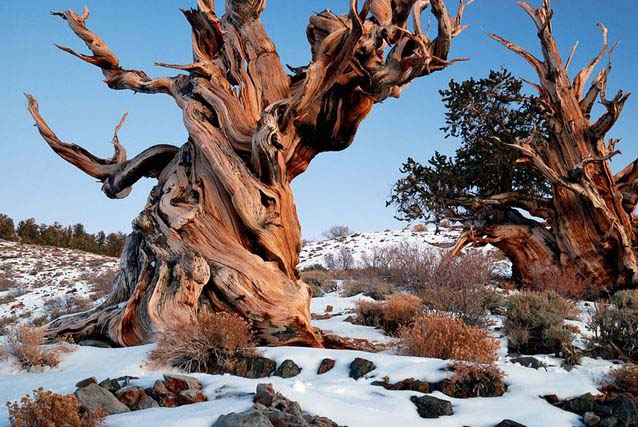The Bristlecone Pine is a highly resilient species with a long lifespan. Broadly referring to what is actually three different species, Bristlecone Pines all thrive in harsh environments with dolomitic soil (alkaline, high in calcium and magnesium, low in phosphorus) and high altitudes. Scattered in subalpine groves, they can be found in the arid regions of the Western United States. These pines’ namesake is derived from the prickles found on the female cones. These eye-catching cones begin with a dark purplish hue, which later shifts to brown as they reach maturity. These tough trees generally perform better in areas where other plants are unable to grow, such as rocky landscapes with bad soil and little to no rainfall. The only downside to their tenacity is that these trees are difficult to cultivate, and often succumb to root rot in garden settings.
Species Variations & Locations:
- Great Basin Bristlecone Pine (Pinus longaeva): The most famous and longest living of the three. Usually the general use of the term ‘bristlecone pine’ is referring to this particular species. Can be found in Utah, Nevada, and Eastern California.
- Rocky Mountain Bristlecone Pine (Pinus aristata): Most populous of the species, and have been successfully cultivated. Found in Colorado, New Mexico, and Arizona.
- Foxtail Pine (Pinus balfouriana): Has two populations, found in either the Klamath Mountains or southern Sierra Nevada. These form the thickest groves of the three.
Roots, Needles, & Wood:
Bristlecone Pines have highly branched, shallow roots with only a few large branching roots that provide structural support. Because of the shallow root system, these trees are extremely drought resistant. Their waxy needles, with thick needle cuticles aid in water retention. Their wood is dense and resinous, which helps promote their longevity through resistance to invasion by insects, fungi, and other potential pests.
Visually, their trunks and limbs are intriguing! Rather than rot away, any exposed wood on a bristlecone pine (both living and dead) erodes like stone, creating interesting and unusual shapes due to the impact of wind and precipitation over time.
